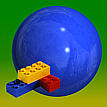
Acrylnitrile contributes with thermal and chemical resistence, and the rubberlike butadiene gives ductility and impact strength. Styrene gives the glossy surface and makes the material easily machinable and less expensive.
Generally, ABS has good impact strength also at low temperatures. It has satisfactory stiffness and dimensional stability, glossy surface and is easy to machine. If UV-stabilizators are added, ABS is suitable for outdoor applications.
Danish Name
Category
Products
Computer mouse
Vacuum jug
KimBox suitcase
Ceramic advanced wet shave razor
Hedge cutter handle
Handle for high pressure cleaner
Shaver, rechargeable
Ensemble chair (ABS blended with PA)
Processes
Plastic injection moulding
Extrusion
Vacuum forming
Printing
Similar materials
ASA
SB
Price
Environmen- tal notes
Use: -
Disposal: Incineration in an incineration plant mainly produces water, carbon dioxide and nitrogen compounds.
Additional Info
Photo
Copyright
This page is part of Design inSite
Disclaimer